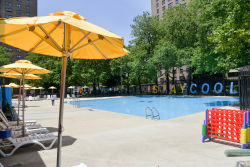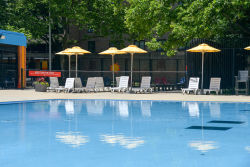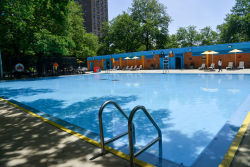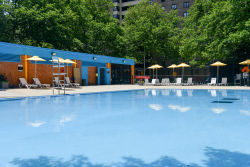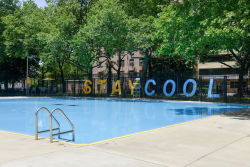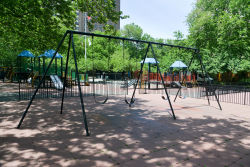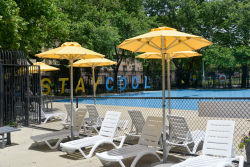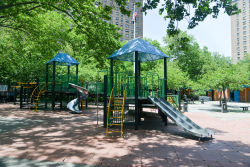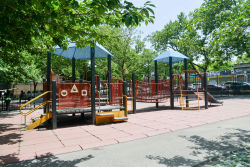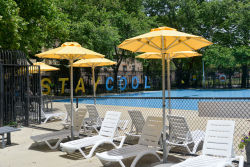Bushwick Playground
Bushwick Pool
For outdoor pool details, including hours and rules, please visit our Free Outdoor Pools page.
The name Bushwick comes from the Dutch word “boswijck,” meaning “heavy woods.” In 1638, Dutch settlers purchased the land from the Native American Canarsie tribe. Twenty-two years later, Dutch Director General Peter Stuyvesant (1610-1672) established a farming community on the land, naming it “Boswyck.” Early settlers included not only the Dutch, but also French, Scandinavian, and English farmers from Massachusetts. After the English seized New Netherlands in 1664, the name “Boswyck” was anglicized into “Bushwick.” In 1834, the town of Bushwick merged with Flatlands, Flatbush, New Utrecht, Gravesend, and Brooklyn to form the City of Brooklyn. Fifty-four years later, the City of Brooklyn consolidated with Manhattan, Staten Island, the Bronx, and Queens to form the new City of New York.
By the time Bushwick was incorporated into the City of New York, the neighborhood had changed dramatically. Beginning in the 1880s, major transportation advances spurred a significant building boom in the area; the Broadway and Myrtle Avenue elevated lines were built in 1888, electrified streetcars made their first appearance around 1900, and the Williamsburg Bridge was constructed in 1903. As the community developed physically, it changed ethnically. Thousands of German and Austrians immigrants settled in Bushwick. They soon made their presence felt, building Lutheran and Roman Catholic Churches, organizing singing societies, and opening many restaurants, beer halls, and breweries. By 1880, there were eleven breweries in Bushwick and nearby Williamsburg. Nearly twenty-five years later, there were four times as many in the area dubbed “brewer’s row,” the most famous being the Rheingold and F and M Schaefer breweries.
The German influence in Bushwick continued into the early twentieth century, although a more diverse immigrant population settled in the community. Both the 1919 Volstead Act (known as the National Prohibition Act) and the onset of the Great Depression ten years later brought significant changes to the community. The local brewing industry, outlawed by Prohibition, no longer served as the cornerstone of the community’s economy. The Depression intensified the economic hardship of the area, and over the subsequent decades, Bushwick’s ethnic composition changed continually. In the 1930s and 1940s, the neighborhood was comprised mostly of Italians. After World War II (1939-1945), white residents left in increasing numbers, and were replaced by African American and Hispanic residents. In the absence of a strong economy, the area’s housing stock began to deteriorate. Residents were hard pressed to maintain their community. By the 1960s, the ever-worsening situation forced the city to focus attention on revitalizing the Bushwick community.
Since then, both the borough of Brooklyn and the City of New York have provided new apartment complexes for residents. Residents themselves have also begun investing their own time and money into improving their community. Many attribute the upswing in community pride and health to the efforts of the East Broadway Merchant’s Association and the Ocean Hill Bushwick Bedford-Stuyvesant Development Corporation.
In May 1956, the City of New York acquired this property, and in December it was transferred to the New York Housing Authority (NYCHA). Originally, the property was part of the Bushwick Houses residential complex, and was known as Bushwick Houses Playground and Pool. In 1987, Parks renamed the property Bushwick Pool.
In the 1990s, Bushwick Pool underwent several renovations. In 1997, as part of a $90,000 capital contract renovation financed by Brooklyn Borough President Howard Golden, the lining of the pool was completely replaced. One year later, Mayor Rudolph Giuliani sponsored a $4500 installation of new chain link fences, guide-rails, and steel fences. In 1999, as part of a $591,315 capital contract rehabilitation funded by City Council member Victor L. Robles, the playground was completely reconstructed. Today, in addition to a pool, this area has play equipment with safety surfacing, benches, handball courts, spray showers, and swings. Near the front of the park, a flagpole flies the United States flag and a yardarm displays the flags of Parks & Recreation and the City of New York.
Check out your park's Vital Signs
Clean & Safe
Green & Resilient
Empowered & Engaged Users
Share your feedback or learn more about how this park is part of a
Vital Park System

